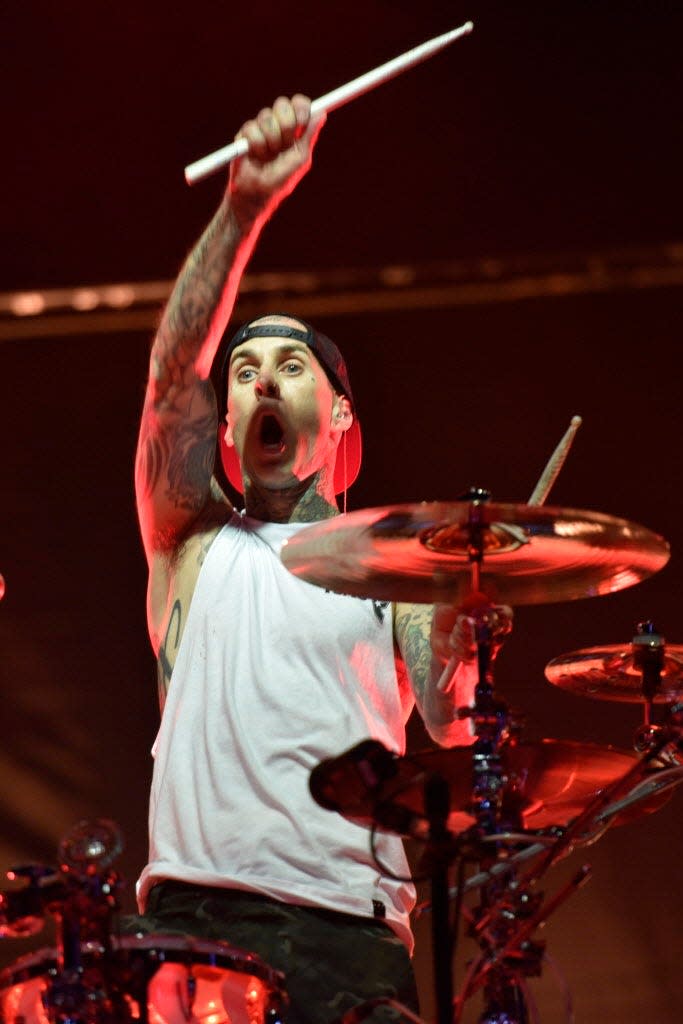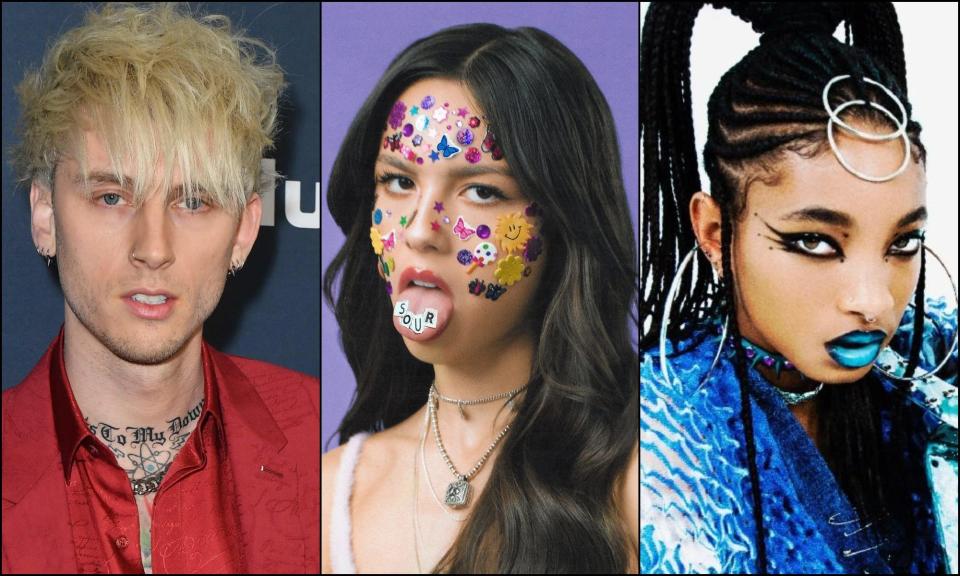From MGK to Olivia Rodrigo, pop-punk’s mainstream comeback is meeting America in the middle
- Oops!Something went wrong.Please try again later.
When pandemic-era restrictions put a damper on full-fledged fun, it was no surprise people collectively craved cultural hallmarks from the the good old days. Now, beloved movies are being revamped for a younger generation, throwback TV series are hitting streaming services and era-defining fashion items are making a comeback. Similarly, the music industry has seen and felt an uptick in nostalgic energy and sounds, and the revitalization of the pop-punk style in particular has made its way into current cultural conversations.
“I think we are all in need of a cathartic experience right now, and pop-punk is a perfect channel for that, (especially) after the political and socio-economic hardships we’ve faced,” entertainment journalist Erica Campbell explains of the genre, which is categorized by a playful combination of bold, brash rock and youthful, bratty pop. “Straight pop isn’t really giving us that emotional breadth rock grants us.”

While The Ramones and The Undertones headed the genre’s beginnings during the ‘70s, pop-punk’s mainstream era occurred between the ‘90s and early-‘00s, with acts like Green Day, Blink-182 and Sum 41 leading the fray. The emergence of emo-flavored pop-punk groups like My Chemical Romance and Fall Out Boy became prevalent in the mid-aughts, but the style’s popularity tapered off in the 2010s as the mainstream gravitated towards dance-pop, EDM, and hip-hop.
Green Day's Billie Joe Armstrong on new album, F-bombs, why Grammys are 'like a bad prom'
At the turn of the decade, however, the nostalgia for this angst-driven style became evident. Thanks largely to production and collaboration assistance from icon Travis Barker of Blink-182, pop and rap artists like Yungblud, Trippie Redd, Halsey, Willow Smith and Machine Gun Kelly released pop-punk-heavy projects. And listeners responded viscerally.
MGK’s album "Tickets To My Downfall" debuted atop Billboard 200 albums chart in September 2020. Burgeoning singer-songwriter Olivia Rodrigo dropped her Hayley Williams-esque breakup anthem “Good 4 U,” nabbing her second No. 1 debut on Billboard’s Hot 100 in May 2021. After releasing her brash debut album "Sour," Rodrigo broke Taylor Swift's streaming songs record with eight simultaneous songs in the Top 10 streaming chart.

Olivia Rodrigo's debut album 'Sour' is pop savagery wrapped in innocence and we're obsessed
“(Pop-punk songs) have a sing-a-long or even anthemic quality, there’s a focus on song structure and melodies,” Nancy Barile, writer, educator, and author of "I'm Not Holding Your Coat: My Bruises-And-All Memoir of Punk Rock Rebellion". “The lyrics are catchy and appeal to the angst and issues young people face or the rebellion they wish for...and that transcends any time period. A good song will always grab a listener, no matter the generation.”
TikTok's influence and a diverse new generation of acts, fans
TikTok also helped to reinvigorate the scene. Some of the platform’s popular viral “challenges” have used early ‘00s pop-punk songs by Simple Plan and Avril Lavigne as background music, and TikTok celebrities Chase Hudson and Jaden Hossler began solo music careers off of the strength of the pop-punk and emo-themed original songs and covers they posted.
“TikTok is the backbone of the music industry,” says avid pop-punk TikToker Yasmine Summan, who amassed more than 90,000 followers on the platform through posts about rock and its subgenres. “TikTok has done massive things for pop-punk, like resurfacing old hits by Paramore and All Time Low and highlighting newer and equally amazing acts. It’s a nostalgic pool of older fans reliving their youth and younger fans having their emo/pop-punk phase for the first time.”
Many of pop-punk’s characteristics have stayed firmly in place during this rise in popularity. However, in observance of the style’s present-day purveyors, this resurgence is clearly more reflective of overall listenership than that of its last major era. Especially during the ‘90s and ‘00s, a particular aesthetic has prevailed among the genre’s mainstream representative: Cis, white, heterosexual men.
Today, artists from all backgrounds thriving. Popular pop-punk acts like Meet Me At The Altar, Baltimore-based quartet Pinkshift and Chicago-based quintet Action/Adventure feature only members of color. While people of color performing pop-punk is nothing new (evident by the successful early-2000s career of Fefe Dobson), inclusionary growth on the scene allows more accessibility for fans of the genre, from representation, to listenership, to support at shows when concerts return in a widespread capacity.

“With a more diverse landscape comes new ideas and new faces,” Summan says. “The more people can see themselves in a genre, the more invested they become emotionally.”
Adds Campbell, “Despite an industry that has tried to pigeonhole artists based on what they define as ‘Black music’ or ‘white music,’ fans today are more interested in the feeling they’re getting from the sound (rather) than trying to figure out whether or not that sound was made just for them.”
'The least punk thing anyone can do is try to police it'
While this is certainly a major mainstream comeback for the style, it can be argued that pop-punk never really went away. London-based music journalist Ali Shutler says that in the UK especially, pop-punk has continued to thrive on the festival circuit with events such as Slam Dunk Fest, Download, and Reading & Leeds centering rock-based artists.
“(These festivals) have always made space for that genre on their lineups, regardless of how it’s doing (on) the charts,” he explains. “I know the saying ‘pop-punk’s not dead’ has always been touted — and there’s some truth to that — but for the first time in a long time, pop-punk’s actually doing something interesting rather than relying on those ‘00s icons.”
As with most resurrected pastimes, some may believe pop-punk’s revival is not a “pure” comeback, since many of the mainstream artists (like Iann Dior, Rico Nasty and Lil Uzi Vert) who employ the sound do not consider themselves to be pop-punk artists. Barile, a high school ELA teacher and punk-rock enthusiast, notes that her students “resent” the idea of pop-punk’s mainstream proliferation as a “trend,” and that mainstream artists are “ruining” the genre.
However, using territorial genre confines and gatekeeper mentality to define who can participate in and be inspired by pop-punk is an outdated way to describe its impact across the industry, especially since sonic cross-pollination is a key reason why the scene found its way back into the conversation. Plus, pop-punk’s influence in other genres doesn’t mean that there aren’t artists within this specific space performing today. Hot Milk, Magnolia Park, and The Tuts are just a few of the acts who call pop-punk home.
“I think the least punk thing anyone can do is try to police it or say what pop-punk is or isn’t,” Barile adds. “So I say ‘whatever.’ Write a good song, put some heart into it, make it real.”
This article originally appeared on USA TODAY: Olivia Rodrigo, MGK and Willow Smith among pop-punk revivalists

